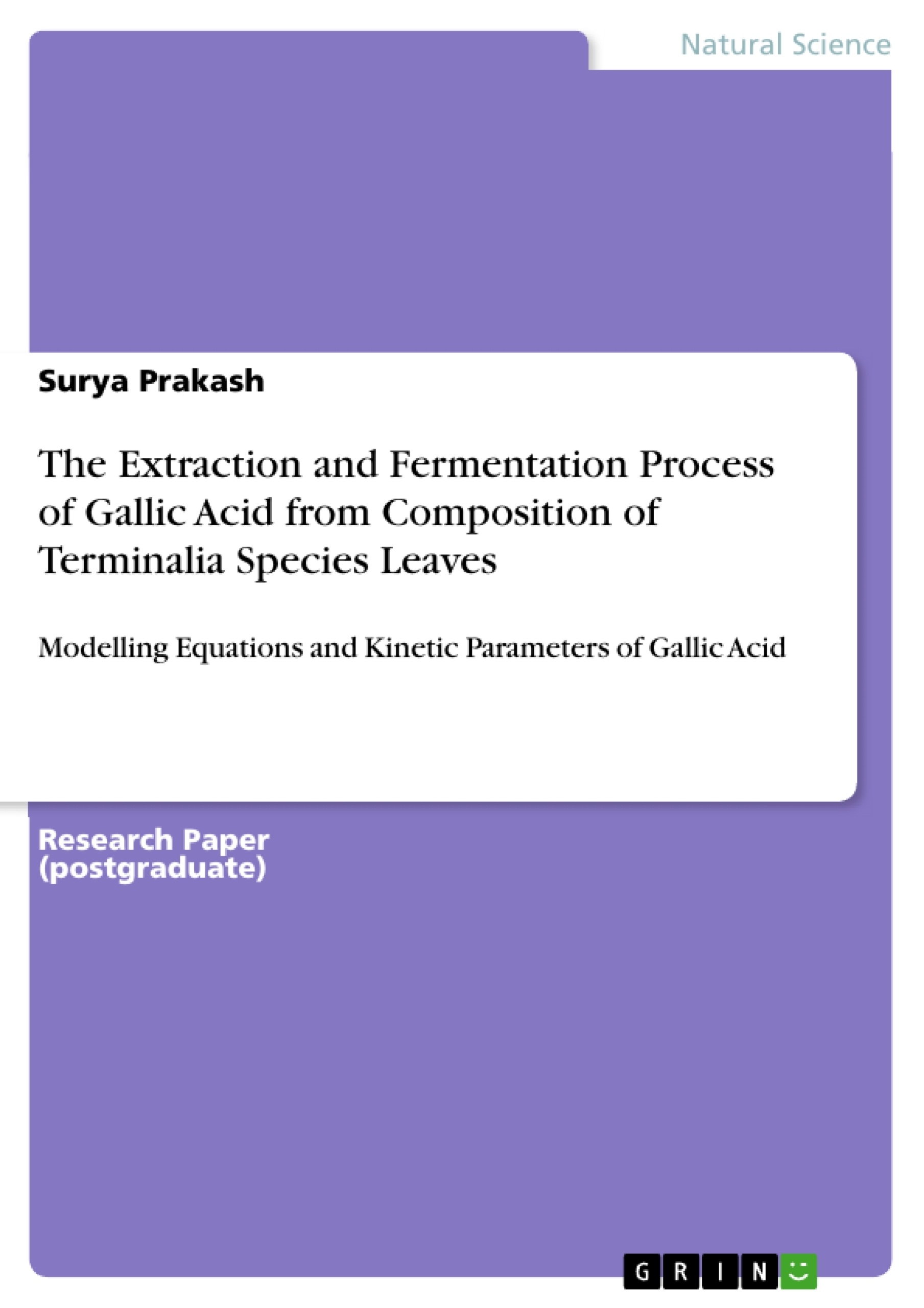Gallic acid is showed best results from fermentation process than extraction process due to biotransformation. In this research, the highest concentration of gallic acid was observed to be 8.7 to 9.0 microgram/ml from the soxhlet extraction and column chromatography process, and the concentration was increased to 9.7 microgram/ml from the fermentation process by Bacillus cereus species. The fermented extracts are showed with the maximum specific growth rate and the maximum yield factor (Yx/s) of Bacillus cereus are 0.3541 hr-1 and 0.234 microgram/ml. The non fermented extracts are showed the modelling equation for the quercetin yield extract was Es = 0.0721(1 - e-0.2867t). The model allowed good accordance with the experimental data by producing average absolute relative deviation from about 9.78 percent.
Keywords: Terminalia species, Gallic acid, Fermentation, Extraction, Bacillus cereus
Inhaltsverzeichnis (Table of Contents)
- Introduction
- Litterature Review
- Material and Methods
- Experimental Procedure
- Results
- Discussion
- Conclusion
- References
Zielsetzung und Themenschwerpunkte (Objectives and Key Themes)
This research project investigates the extraction and fermentation process of gallic acid from the leaves of Terminalia species, specifically focusing on the potential of Bacillus cereus for enhancing gallic acid production. The study aims to compare the efficiency of traditional extraction methods with fermentation techniques and to analyze the influence of fermentation on the yield and specific growth rate of Bacillus cereus.
- Extraction and fermentation of gallic acid from Terminalia species leaves
- Comparative analysis of extraction and fermentation methods for gallic acid production
- Role of Bacillus cereus in enhancing gallic acid yield
- Modeling of quercetin yield extract in non-fermented extracts
- Pharmacological properties and applications of gallic acid
Zusammenfassung der Kapitel (Chapter Summaries)
- Introduction: This chapter provides an overview of Terminalia arjuna, a medicinal plant known for its diverse pharmacological properties, including cardiovascular, anti-inflammatory, and antimicrobial activities. It highlights the plant's origin, phytoconstituents, and traditional uses.
- Litterature Review: This chapter delves into existing research on the extraction and fermentation of gallic acid from plant sources. It explores various methods, including soxhlet extraction and column chromatography, and discusses the potential of microorganisms, particularly Bacillus cereus, for enhancing gallic acid production.
- Material and Methods: This chapter outlines the experimental procedures employed in the research project. It describes the materials used, the extraction and fermentation processes, and the analytical techniques used to determine gallic acid concentration.
- Results: This chapter presents the findings of the study, including the gallic acid concentrations obtained from both extraction and fermentation methods. It also provides information on the specific growth rate and yield factor of Bacillus cereus during fermentation.
- Discussion: This chapter analyzes the results and discusses the significance of the findings in the context of existing literature. It explores the potential of Bacillus cereus for enhancing gallic acid production and the implications for further research and applications.
Schlüsselwörter (Keywords)
This research focuses on the extraction and fermentation of gallic acid from Terminalia species leaves, utilizing Bacillus cereus as a fermentation agent. The key themes encompass comparative analysis of extraction and fermentation methods, the influence of Bacillus cereus on gallic acid yield, and the pharmacological properties of gallic acid.
- Quote paper
- Surya Prakash (Author), 2018, The Extraction and Fermentation Process of Gallic Acid from Composition of Terminalia Species Leaves, Munich, GRIN Verlag, https://www.grin.com/document/419298



